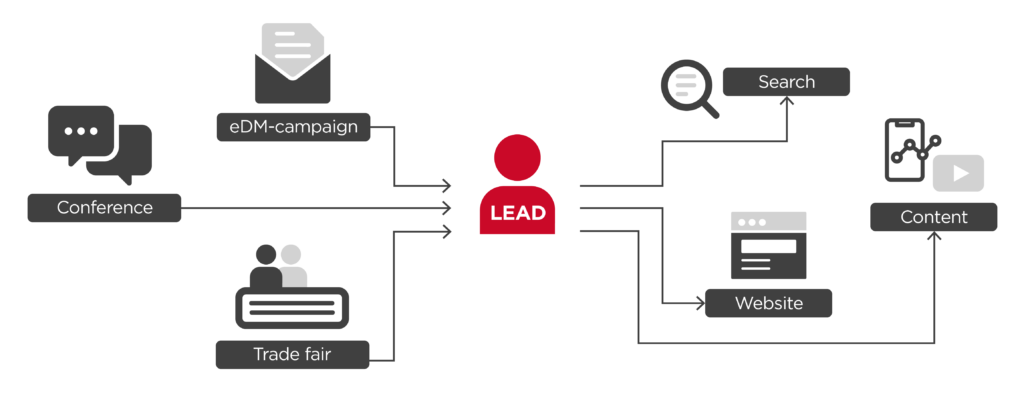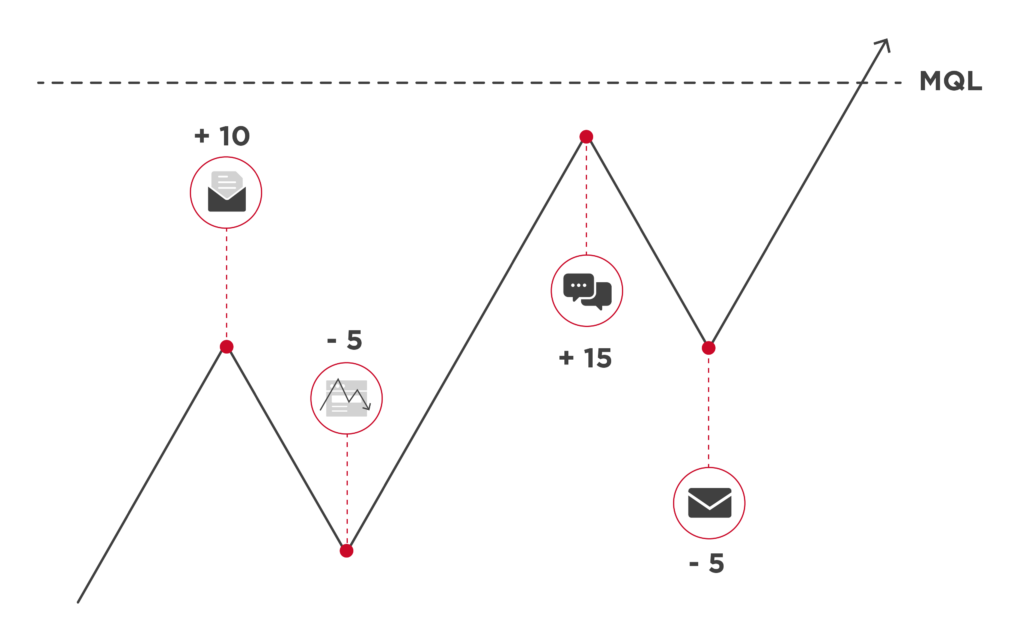Imagine this: someone visits your website and downloads a catalogue. This doesn’t come as a surprise, you already know the visitor. You know their name is Annie Johnson and that she’s the Purchasing Manager at a large corporation. You know she has recently viewed a new product, after clicking through from an email you sent. Last but not least, you know this is the time for sales to win the client.
Now imagine you have a system to manage data for all your website visitors. That’s called marketing automation. Here’s how it works:
In marketing automation, a lot depends on your leads. A lead is someone who enters personal data in order to request a catalogue, download a whitepaper, or get any other type of content. A lead is showing interest in your products or services, which makes them a prospective client. But to make them convert, we need more information.
How they interact with your company can help assign a score to any lead. Then we can define their position in the buyer’s journey and choose the appropriate content to reach them.
1. Leads: a fragmented life cycle
It’s very well possible that a lead interacts with your brand at multiple touchpoints – think conferences or trade shows, eDM campaigns, online search engines, websites, or print and digital content.
This could lead to a fragmented lifecycle. For instance, a lead might learn about your brand at a trade show, then discover your website through an advertising campaign, and later subscribe to your newsletter.

How to deal with a fragmented life cycle?
Marketing automation helps you act on leads’ complicated life cycles with customer-centric, multichannel, personalised marketing across all stages of the buyer’s journey.
Marketing automation provides you with an overview of a lead’s entire life cycle
It allows to:
- Track all touchpoints and channels through which a lead interacts with your company (online and offline).
- Follow the lead’s journey, so you can guide them towards conversion.
Automated workflows, pre-defined scenarios, and customer-driven triggers are set up in a connected and omnichannel way. To achieve this connected approach, you need to get an overview from a customer or persona’s perspective.
2. Lead nurturing: personalised and segmented
All prospects have different needs, buying cycles and processes. As a marketer, it’s best to approach each lead individually. But there are steps in the workflow that you can repeat for each lead.
Here’s an example:

But what if your lead doesn’t respond to the webinar invite? With marketing automation, you can adapt subsequent actions to the precise activity of the lead. This allows you to individually guide each lead’s journey to conversion.
Marketing automation saves you time and money by automizing workflows, without compromising on a personal approach for each lead. This amounts to quality prospects.
Personal, segmented lead scoring ensures you strengthen ties with each contact. It allows your communication to be relevant to the context; lets you learn more about a lead’s needs; and seamlessly guides them from one step to the next. This way, you can define when to put effort into a contact and when to take a step back and let them find things out on their own.
3. Lead scoring: defining who really matters
When a lead shows interest to buy, they become a Marketing Qualified Lead (MQL). But even then, not all leads are as relevant. Only 13% of MQLs in B2B become an opportunity for sales, a Sales Qualified Lead (SQL). (source: Salesforce and Implisit)
Further reading:
Why do people buy from you? The B2B Elements of Value help provide an answer.
Here’s the challenge: how do you distinguish relevant, quality leads from those that are still shopping around and considering multiple purchasing options?
This is where lead management comes in, or even better: lead scoring.
Lead scoring is an essential part of modern lead management. By monitoring your prospect’s behaviour and internet activity, you know to what extent they are interested in your solution (engagement) and how relevant they are to your organization (demographics and business demographics). Converting qualified leads to clients requires combining both aspects.
To indicate whether a lead is ready to buy, you can assign them a score or value based on three criteria:
- Completion – do you have the minimum required data for the lead: their name and email address?
- Fit – does the lead match the persona of your ideal prospect?
- Engagement – how are they interacting with your content and marketing messages?
Here’s an example:

A CTO who has visited your product and pricing pages will get a higher score than a junior employee taking the same actions. You might also assign leads with the same job role a different score, based on the intensity of their interaction with your website. This way, lead scoring helps define which leads are ready to pass on to sales.
What are the benefits of an efficient lead scoring model?
1. Smoother and more effective sales
Lead scoring helps focus your attention on relevant prospects. A contact with a low score, will not be passed on to your sales department. You can prioritize and make sure the sales team gets only quality leads, thereby making conversions increase.
2. Result-driven marketing
A lead scoring model maps out which types of leads or characteristics are most important to you. This allows you to target messaging and campaigns better and to provide sales with high-quality leads.

3. Better marketing and sales alignment
Lead scoring helps define in a uniform way when leads are ready for the next stage in the buyer’s journey. You avoid conflicts between marketing and sales about what constitutes a ‘qualified’ lead. Lead scoring is a common tool for both teams to make joint judgment on the amount and quality of gathered leads.
Is marketing automation right for you?
If you read this article and haven’t started on marketing automation, things might seem a bit confusing. Get in touch and we can support you in defining, collecting, scoring and nurturing leads on the path to conversion.
Are you using marketing automation but not getting the results you hoped for? Give us a shout. Together, we will outline which leads really matter and get into meaningful conversations with relevant prospects.






